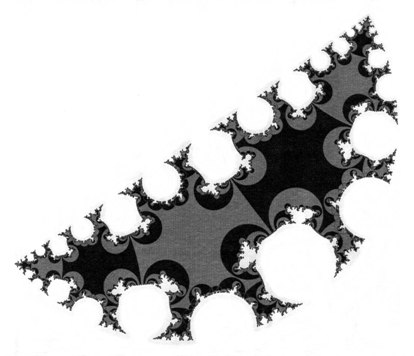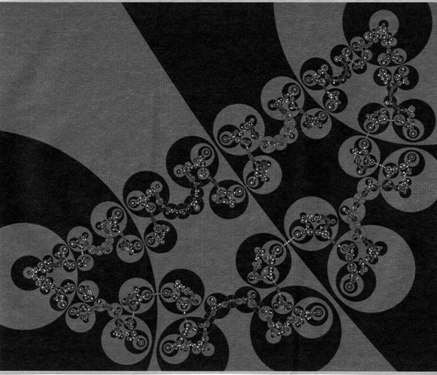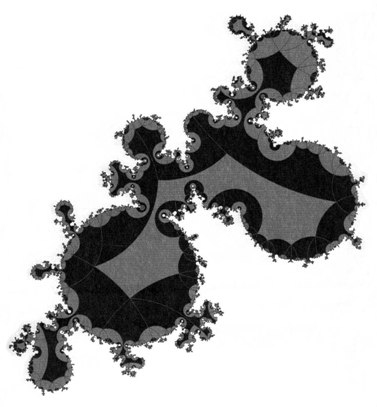Tomaschitz, R. (1992). Quantum chaos on hyperbolic manifolds: A new approach to cosmology, Complex Systems 6, 137-161.
Abstract (Complex Systems, CDS, SAO/NASA ADS, Zbl 0767.58053)
We consider classical and quantum motion on multiply connected hyperbolic spaces, which appear as space-like slices in Robertson-Walker cosmologies. The topological structure of these manifolds creates on the one hand bounded chaotic trajectories, and on the other hand quantal bound states whose wave functions can be reconstructed from the chaotic geodesics. We obtain an exact relation between a probabilistic quantum mechanical wave field and the corresponding classical system, which is likewise probabilistic because of the instabilities of the trajectories with respect to the initial conditions. The central part in this reconstruction is played by the fractal limit set of the covering group of the manifold. This limit set determines the bounded chaotic trajectories on the manifold. Its Hausdorff measure and dimension determine the wave function of the quantum mechanical bound state for geodesic motion.
We investigate relativistic scalar wave fields in de Sitter cosmologies, coupled to the curvature scalar of the manifold. We study the influence of the topological structure of space-time on their time evolution. Likewise we calculate the time asymptotics of their energies in the early and late stages of the cosmic expansion. While in the late stages both bounded and unbounded states approach the same rest energy, they show significantly different behavior at the beginning of the expansion. While the stable bound states have simple power law behavior, extended states show oscillations in their energy, with a frequency and an amplitude both diverging to infinity, indicating the instability of the quantum field at the beginning of the cosmic expansion.
Zbl
0767.58053
Tomaschitz, Roman
Quantum chaos on hyperbolic manifolds: A new approach to cosmology
[J] Complex
Syst. 6, No.2, 137-161 (1992). ISSN 0891-2513
MSC 2000:
*58Z05
Appl. of global analysis to physics
83F05 Relativistic cosmology
81Q50 Quantum chaos
37N99 Applications of dynamical systems
32Q45 Hyperbolic and Kobayashi hyperbolic manifolds
Keywords: quantum chaos; hyperbolic manifolds; cosmology
|
Title: |
|
Quantum chaos on hyperbolic manifolds: A new approach to cosmology |
|
Authors: |
|
Tomaschitz, Roman |
|
Affiliation: |
|
AA(Instituts Internationaux de Physique et de Chimie Solvay Université Libre de Bruxelles, C.P. 231 Campus Plaine, Bd. du Triomphe, B-1050 Brussels, Belgium) |
|
Publication: |
|
Complex Systems 6, 137-161 (1992) |
|
Publication Date: |
|
04/1992 |
|
Origin: |
|
AUTHOR |
|
Keywords: |
|
chaos in cosmology, relativistic chaos, Robertson-Walker cosmology, multiply connected 3-space |
|
Abstract Copyright: |
|
1992 Complex Systems Publ. |
|
Bibliographic Code: |
|
![Figure 4: If we apply the discrete group Γ generated by the side-pairing mappings in figure 3(b) to the free polyhedral faces f1 and f2, we get a tiling of the interior Γ(f1) and the exterior Γ(f2) of the Jordan curve Λ(Γ). This curve itself emerges as the set of accumulation points of Γ-images (tiles) of f1 and f2. Λ(Γ) is the support of the Hausdorff measure in the integral representation of the wave function, and constitutes the set of initial and end points of lifts of bounded trajectories. Its Hausdorff dimension δ gives the ground state energy. For the calculation of δ from the tiling see [17]. δ = 1.277 ± 0.001.](FIG_quantum_chaos_hyperbolic_manifolds/Fig4-30.jpg)
Figure 4: If we apply the discrete group Γ generated by the side-pairing mappings in figure 3(b) to the free polyhedral faces f1 and f2, we get a tiling of the interior Γ(f1) and the exterior Γ(f2) of the Jordan curve Λ(Γ). This curve itself emerges as the set of accumulation points of Γ-images (tiles) of f1 and f2. Λ(Γ) is the support of the Hausdorff measure in the integral representation of the wave function, and constitutes the set of initial and end points of lifts of bounded trajectories. Its Hausdorff dimension δ gives the ground state energy. For the calculation of δ from the tiling see [17]. δ = 1.277 ± 0.001. full size image

Figure 5: A tesselation corresponding to a manifold with fig. 3(b) as an identification pattern; we have drawn Γ(f1), the interior of the Jordan curve. Different realizations (figures 4 and 5) of the same pattern lead to non-isometric manifolds and different limit sets. These fractal limit sets on the boundary of the universal covering space completely determine both the bounded trajectories and the ground state wave function. δ = 1.289. full size image

Addendum to figure 5. full size image
![Figure 6: Same as figure 4, but for the pattern in figure 3(a). A quasiconformal, quasi-isometric deformation ω of the unit disk (see section 3) gives rise to this embryonic shape, whose boundary is quasi-self-similar [1]: homothetically magnifying an arbitrarily small piece of the curve, we observe similar shapes (in the sense of a quasi-isometry) as we do on the scale of the whole figure. δ = 1.300.](FIG_quantum_chaos_hyperbolic_manifolds/Fig6-30.jpg)
Figure 6: Same as figure 4, but for the pattern in figure 3(a). A quasiconformal, quasi-isometric deformation ω of the unit disk (see section 3) gives rise to this embryonic shape, whose boundary is quasi-self-similar [1]: homothetically magnifying an arbitrarily small piece of the curve, we observe similar shapes (in the sense of a quasi-isometry) as we do on the scale of the whole figure. δ = 1.300. full size image

Figure 7: Same as figure 5, but for a manifold with the topology of figure 1 and the identification pattern in figure 2. This cluster is obviously quasi-self-similar; see the caption of figure 6. δ = 1.319. full size image
description: Roman Tomaschitz (1992) Quantum chaos on hyperbolic manifolds: A new approach to cosmology, Complex Systems 6, 137.
Keywords: chaos in cosmology, relativistic chaos, open Robertson–Walker cosmology with multiply connected hyperbolic 3-space, de Sitter universe, constant negative curvature, Klein–Gordon equation on open hyperbolic 3-manifolds, energy–momentum tensor of scalar wave fields on hyperbolic 3-manifolds, cosmic time evolution and positivity of energy, Poincaré series, Poincaré half-space model of hyperbolic geometry, universal covering projection, polyhedral tessellation of hyperbolic space, quasi-self-similar limit sets of Kleinian groups, quasi-Fuchsian covering groups, Jordan curves, Hausdorff measure and dimension, hyperbolic convex hull of a fractal limit set, mixing in the chaotic nucleus of the open 3-space, ground state energy of scalar quantum fields on open hyperbolic 3-manifolds, ground-state wave function, Poisson kernel, fibered hyperbolic 3-manifolds, compact Riemann surfaces, Teichmüller deformation spaces, quasiconformal deformations, Beltrami equation, isothermal coordinates at infinity of hyperbolic space
download full-text article (scanned PDF, 2.6 MB)